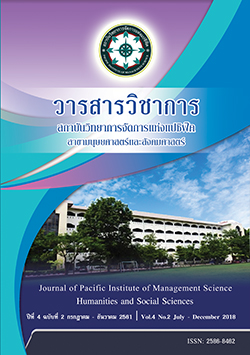Quality of management in educational institutions
Keywords:
Quality manager place of EducationalAbstract
Management by overview Affect the success of the organization. Even if it is not visible. It can be measured and evaluated. Management makes resources cost-effective and productive. The organization will achieve its goals. Management is a technique that brings together members of the organization. In practice, management intent is to determine the scope of work of the members of the organization. And it is the best way to work. It also helps to improve the quality of life of personnel. And it is the best way to work. Management helps create employment. People make money. It is a mechanism to drive the economy in society and the nation. Globalization makes any operation. The complexity is growing. The context has changed dramatically. The future of organizations, both public and private, is difficult to predict what will happen in the near future. Both positive and negative effects on the environment. This is a highly competitive era. To be effective management. And the plan. Key Skills of Management It is important to be able to sustain the organization itself. There are three levels of management: high, middle and high. ”Management is an activity„ because management must design the work of the organization to support and guide the way people work. Individuals in the organization align with organizational goals. The role of middle management in management Mid-level executives play an important role in implementing a master plan or policy into a work plan. And is responsible for evaluating the performance. To lead the solution, change, change and define the corporate policy. It is a link between top management and top management. But before the details of each skill. We should understand the executive meaning. As well as duties And the role of administration. To lead the direction. In this case, we will discuss the important qualities of good and effective school administrators.
References
ทิศนา แขมมณีและคนอื่น ๆ. (2540). การคิดและการสอนเพื่อพัฒนากระบวนการคิด. กรุงเทพฯ :โครงการพัฒนาการเรียนการสอน สำนักงานคณะกรรมการการศึกษาแห่งชาติ.
ทวี ทองคำ. (2544). ผู้บริหารมือใหม่ในโรงเรียนประถมศึกษา: ผลการวิจยัเพื่อการวิพากษ์. กรุงเทพฯ: ทิพย์วิสุทธิ์.
ทัศนีย์ พรหมไพจิตร. (2541). ปัจจัยที่มีความสัมพันธ์ต่อการต้องการศึกษาต่อในระดับมัธยมศึดษาตอนต้นของเยําวชนไทยมุสลิม. วารสารสงขลานครินทร์.
พระราชบัญญัติการศึกษาแห่งชาติ พ.ศ. 2542 และที่แก้ไขเพิ่มเติม (ฉบับที่ 2) พ.ศ. 2545 พร้อมกฎกระทรวงที่เกี่ยวข้อง และพระราชบัญญัติการศึกษาภาคบังคับพ.ศ. 2545. กรุงเทพฯ: โรงพิมพ์องค์การรับส่งสินค้าและพัสดุภัณฑ์ (ร.ส.พ.), 2546
พิมพ์อร สดเอี่ยม. (2547). ปัจจัยที่มีอิทธิพลต่อประสิทธิการบริหารวิชาการของสาขาวิชาในระดับบัณฑิตศึกษาของสถาบันราชภัฏ. ดุษฎีนิพนธ์การศึกษาดุษฎีบัณฑิต. กรุงเทพฯ: มหาวิทยาลัยศรีนรินทรวิโรฒประสานมิตร.
ภารดี อนันต์นาวี. หลักการ แนวคิด ทฤษฎีทางการบริหารการศึกษา. ชลบุรี: (2551).
ราชันย์ บุญธิมา. (2545). ปัจจัยเชิงพหุระดับที่มีผลต่อตัวแปรระดับห้องเรียน. กรุงเทพฯ: ไทยวัฒนาพานิช.
รุ่ง แก้วแดง. (2545). ปฏิวัติการศึกษาไทย. กรุงเทพฯ: มติชน.
รุ่ง แก้วแดง. (2536). โรงเรียนนิติบุคคล. กรุงเทพฯ: ไทยวัฒนาพานิช.
วาโร เพ็งสวัสดิ์. (2549). การพัฒนารูปแบบความสัมพันธ์โครงสร้างเชิงเส้นตรงของประสิทธิผลของภาวะผู้นำของผู้บริหารสถานศึกษา. วิทยานิพนธ์ ศศ.ด.(การบริหารการศึกษา). ขอนแก่น: บัณฑิตวิทยาลัย มหาวิทยาลัยขอนแก่น.
สัมฤทธิ์ กางเพ็ง. (2551). ปัจจัยการบริหารที่มีอิทธิพลต่อประสิทธิผลของโรงเรียน:การพัฒนาและการตรวจสอบความตรงของตัวแบบ. วิทยํานิพนธ์ ศศ.ด. (การบริหารการศึกษา). ขอนแก่น: บัณฑิตวิทยาลัย มหาวิทยาลัยขอนแก่น.
ทิศนา แขมมณีและคนอื่น ๆ. (2540). การคิดและการสอนเพื่อพัฒนากระบวนการคิด. กรุงเทพฯ: โครงการพัฒนาการเรียนการสอน สำนักงานคณะกรรมการการศึกษาแห่งชาติ.
สัมฤทธิ์ กางเพ็ง.(2551). ปัจจัยการบริหารที่มีอิทธิพลต่อประสิทธิผลของโรงเรียน: การพัฒนาและการตรวจสอบความตรงของตัวแบบ. วิทยานิพนธ์ ศศ.ด. (การบริหารการศึกษา).ขอนแก่น: บัณฑิตวิทยาลัย มหาวิทยาลัยขอนแก่น.
อำรุง จันทวานิช. (2547). แนวทํางการบริหารและการพัฒนาสถานศึกษาสู่โรงเรียนคุณภาพ. กรุงเทพฯ: วัฒนาพานิช.
สำนักงานคณะกรรมการการศึกษาแห่งชาติ. (2553).พระราชบัญญัติการศึกษาแห่งชาติ. กรุงเทพฯ: พริกหวานกราฟฟิค.
สมใจ ลักษณะ. (2542). การเสริมประสิทธิภาพในการทำงาน. กรุงเทพฯ: ธนรัชการพิมพ์.
สำนักงานคณะกรรมการส่งเสริมการศึกษาเอกชน. (2545). คู่มือปฏิบัติงานคณะกรรมการพัฒนาระบบข้าราชการ.กรุงเทพฯ: โรงพิมพ์คุรุสภา.
สำนักงานรับรองมาตรฐานและประเมิน (2552). คุณภาพการศึกษาองค์กรมหาชน. กรุงเทพฯ: พิมพ์ดี.
Glickman. (1987). Assessing the innovation capacity of the consortium: An evaluation of the CAM-I cost management systems program. Journal of Knowledge Management.
Gordon. (1990). Organizational Behavior: A Diagnostic Approach. Upper Saddle River, NJ: Prentice Hall International
Levine & Orntein. (1989). Educational Administration : Concepts and practices. Belmont, Ca:Wadswarth.
Orntein. (1990). Educational Administration : Concepts and practices. Belmont, Ca:Wadswarth.
Robbins. (1990). Organizational Behavior: Concepts, Controversies, and Applications. (8th ed). Englewood Cliffs, N.J.: Prentice – Hall International, Inc.
Stephen P. Robbins. (1983). Organizational Behavior: Concepts, Controversies, and Applications.(8th ed). Englewood Cliffs, N.J.: Prentice – Hall International, Inc.
Downloads
Published
Issue
Section
License
บทความที่ได้รับการตีพิมพ์เป็นลิขสิทธิ์ของ สถาบันวิทยาการจัดการแห่งแปซิฟิค
ข้อความที่ปรากฏในบทความแต่ละเรื่องในวารสารวิชาการเล่มนี้เป็นความคิดเห็นส่วนตัวของผู้เขียนแต่ละท่านไม่เกี่ยวข้องกับสถาบันวิทยาการจัดการแห่งแปซิฟิค และคณาจารย์ท่านอื่นๆในสถาบันฯ แต่อย่างใด ความรับผิดชอบองค์ประกอบทั้งหมดของบทความแต่ละเรื่องเป็นของผู้เขียนแต่ละท่าน หากมีความผิดพลาดใดๆ ผู้เขียนแต่ละท่านจะรับผิดชอบบทความของตนเองแต่ผู้เดียว







